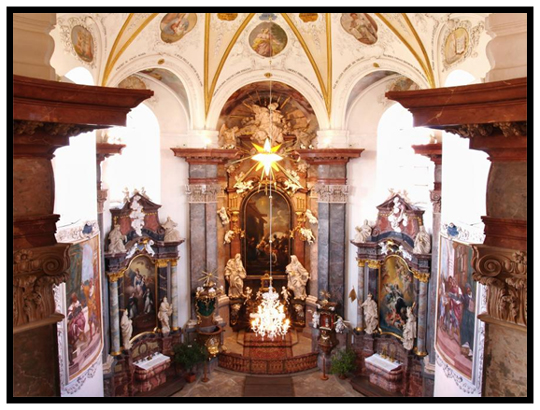Visiting the Czech Republic
Column #359 July 22, 2022
Greetings from Smiřice, a small community just north of Hradec Králové, a city in the Czech Republic. We’re here tonight because Dr. Michael Šust and his family and friends are giving a concert at the Baroque Chapel of Smiřice. (See column image.)
Linda and I are here because she provides the piano accompaniment and I help out with the video. Maybe many of you remember hearing and watching Czech-born, American bass-baritone Michael Šust and his family perform with the Smiling String Orchestra in the video I wrote about last March. If you do, you know the performance will be top notch.1
The Baroque Chapel of Smiřice is a very unique and famous church. Visitors say it’s almost magical not only for the eye, but in its beautiful atmosphere for concerts. “It was Jan Josef, the count of Šternberk who had the Castle Chapel of the Epiphany built between 1699 and 1711. The chapel is regarded as a highly valuable baroque construction. Its complicated ground plan of concave-convex design has a shape of a slightly elongated octagon. The chapel is valued not only for its architectonic qualities, but also for its unique, compact and style integrated interior which hasn’t gone through any major changes ever since the construction was completed.” It’s certainly worth visiting.2
The Czech Republic (30,452 square miles) is slightly smaller than South Carolina (32,020 square miles). South Carolina ranks 40th in size compared to all 50 states. The Czech Republic ranks 22nd in size compared to the nearly 50 European countries. It is a landlocked country in Central Europe that historically was known as Bohemia. Its neighboring countries are Austria to the south, Germany to the west, Poland to the northeast, and Slovakia to the southeast. It has a hilly landscape with a mostly temperate continental and oceanic climate. The capital and largest city is Prague.3 4 5
For a big picture historical view, Oxford Reference lists a timeline for Bohemia that dates back to c. 35,000 years ago. It starts with describing the earliest known inhabitants who were Paleolithic hunter-gatherers that were using mammoth tusks and bones to support hide-covered tents at Dolni Vestonice (in the modern day Czech Republic). For more recent history one can refer to the Czech Republic article from Wikipedia.6 7
In the days ahead our additional stops in Czechia include Prague, Brno, Pardubice, Kunětice Fortress, Osice, and Chlumec. We even have a concert stop planned in Vienna, Austria. So it’s a very intense trip with four planned concerts and who knows how many spontaneous ones.
The food here is certainly different, but satisfying. Most of the beef is grass-fed or mostly so! (Warning, beef servings are tiny.) For sure the food is hearty yet varied. I’m going to try as many of the top traditional Czech dishes as I can. The Travel Food Atlas website sure makes them sound and look good. Of course I can’t pronounce their names.8
After landing in Prague around noon, we spent two nights there getting acclimated to Florida’s six-hour time difference. That also permitted some sightseeing. For certain this city is a step back in time. A huge attraction, the Charles Bridge in Prague, was built from 1357-1402. It’s mind-boggling to behold this bridge—by even today’s standards. What a rich history, yet most Americans don’t have a clue about any aspect of European history.
Since we know the politicians and bureaucrats making up our Federal government do a lousy job of managing domestic issues in our own country, we can only assume it does a far worse job of managing foreign relations in Europe and elsewhere where the history is far more complex than our own. How is it that American elitists and members of The Great Rest believe they know how all the citizens of the world’s many countries should function?
On the surface, Czechs seem to be very much like us Americans. They are technologically savvy and modern. Of course, like all nationalities, they have a few distinctive physical and many ethnic differences when compared to other nationalities—even when compared to citizens of neighboring countries. Their history is also way different. Czechs had periods of great achievements, times of darkness, foreign occupation, even a period of living under communist rule—all of which were brought on by various leaders and conquerors. Interestingly, a thousand years ago the country was quite religious. Today it is one of Europe’s most atheistic countries.
We haven’t walked in their shoes for sure.
To your health.
Ted Slanker
Ted Slanker has been reporting on the fundamentals of nutritional research in publications, television and radio appearances, and at conferences since 1999. He condenses complex studies into the basics required for health and well-being. His eBook, The Real Diet of Man, is available online.
Don't miss these links for additional reading:
1. Smiling String Orchestra Column #341, March 18, 2022 by Ted Slanker
2. The Castle Chapel of the Epiphany
3. How Big Is Each State in the U.S.? by Amanda Briney from ThoughtCo
4. European Countries by Area from Wikipedia
5. Czech Republic from Wikipedia
6. Timeline: Bohemia Years: c. 35,000 years ago—1993 from Oxford Reference
7. Timeline: Prehistory Years: c. 6 million years ago—3100 BCE from Oxford Reference
8. Czech Food: 11 Must-Try Dishes of the Czech Republic from Travel Food Atlas
9. Charles Bridge Statues Walking Tour from Big Boy Travel
10. Incredible Animation Shows How Bridges Were Built in 14th-Century Prague by Samantha Pires from My Modern Met
11. History Of Prague from Prague Experience Guide




